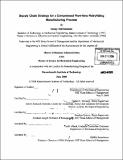Supply chain strategy for a compressed flow-time retrofitting manufacturing process
Author(s)
Subramanian, Sanjay
DownloadFull printable version (18.01Mb)
Other Contributors
Leaders for Manufacturing Program.
Advisor
Daniel E. Whitney and Stephen C. Graves.
Terms of use
Metadata
Show full item recordAbstract
In today's competitive environment, a compressed flow-time enables companies to present a strong value proposition especially for products with a high asset value. In a retrofitting manufacturing process the state of incoming product and customer requirements is unpredictable. This results in long flow-times from customer order to delivery of completed product. The uncertainty involved in identifying the parts forces companies to complete the engineering analysis and design before procuring parts from the supplier. The freighter conversions group at The Boeing Company is in the business of retrofitting passenger planes into cargo planes. The group is exploring ways to significantly reduce the overall conversion flow-time.This thesis presents an approach to group parts based on its reusability percentage and lead-time. The thesis then introduces a partially decoupled model where different strategies are applied to each group to reduce the overall flow-time.The analysis reveals a high degree of reusability in the retrofitting manufacturing process. Up to 90% of parts were used in every single conversion. When the highly variable parts are excluded, a strategy of ordering and stocking parts before the completion of engineering tasks can help reduce the flow-time with minimal risk. The results show that flow-time can be reduced from 27 to 11 with an investment of less than 1% of annual part cost in safety stock. The obsolescence risk associated with this strategy is less than 0.5% of annual part cost. The analysis further shows that there is a non-linear relationship between flowtime reduction and the investment required in safety stock and obsolescence risk. The analysis presented in this thesis is the result of work done during a 6.5 month LFM internship at The Boeing Company in Everett, Washington.
Description
Thesis (M.B.A.)--Massachusetts Institute of Technology, Sloan School of Management; and, (S.M.)--Massachusetts Institute of Technology, Dept. of Mechanical Engineering; in conjunction with the Leaders for Manufacturing Program at MIT, 2008. Includes bibliographical references (p. 57).
Date issued
2008Department
Leaders for Manufacturing Program at MIT; Massachusetts Institute of Technology. Department of Mechanical Engineering; Sloan School of ManagementPublisher
Massachusetts Institute of Technology
Keywords
Sloan School of Management., Mechanical Engineering., Leaders for Manufacturing Program.